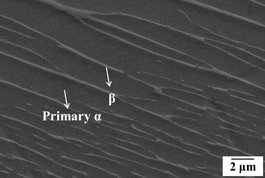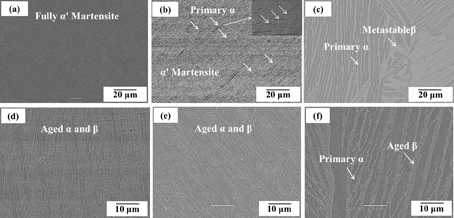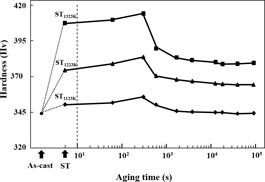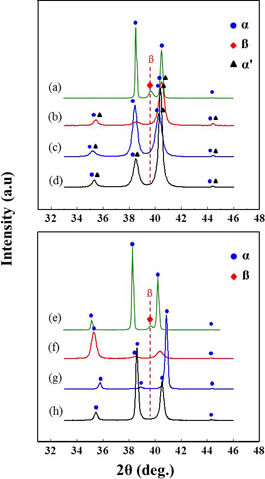2017 Volume 58 Issue 8 Pages 1145-1149
2017 Volume 58 Issue 8 Pages 1145-1149
We investigated effect of retained β phase on mechanical properties of cast Ti-6Al-4V alloy, after solution treatment and subsequent aging for a short time. The alloy was solution-treated at 1123, 1223 K in the α + β phase region and 1323 K in the β phase region for 1800 s, followed by water quenching. After that, as-quenched specimens were aged at 823 K for 300 s. The peak hardness of heat-treated specimens was obtained by solution treatment at each solution temperature and followed by aging at 823 K for 300 s. It was due to fine α phase transformed from the retained β phase. The tensile strength of specimen as-quenched at 1223 K and subsequent aged at 823 K for 300 s was increased, without significantly decreased ductility. This was due to the fine α phase transformed from the retained β phase by subsequent aging for 300 s. This behavior of increased strength without dramatically decreased ductility might be caused by the transformation induced plasticity (TRIP) effect, which is the strain-induced martensite transformation from the retained β phase throughout deformation, even after aging at 823 K for 300 s.
Ti-6Al-4V alloy has been utilized in various applications by virtue of its light weight, excellent specific strength, and outstanding combination of strength and ductility.1) Additionally, this alloy has high potential for further strengthening through a microstructure control. Owing to this attractive potential and heat-treatable feature, a number of scientists have investigated heat treatments to obtain a variety of microstructures and outstanding mechanical properties of this alloy.2,3)
Solution and aging treatments of Ti-6Al-4V alloy are one of the common heat treatments. Through this heat treatment, the tensile strength of this alloy is increased by α' martensite formed from β phase after solution treatment, and the fine α and β phases decomposed from α' martensite by aging treatment.3–6) Moreover, further improvement of strength and toughness is obtained by nano-sized precipitates of α2(Ti3Al) phase after over-aging treatments at 723~923 K for long aging time. However, the problem of this heat treatment for the α2 phase is that it takes a relatively long aging time generally over 360000 s.5,7) On the other hand, several studies have reported that strength and ductility are more improved by solution treatment and subsequent aging for a short time of about 70 s, resulting from a strain-induced martensite transformation of the retained β phase under deformation.2,8,9) This result indicates that the combination of strength and ductility of Ti-6Al-4V alloy can be further improved by retained β phase, even for a short time. Although Ti-6Al-4V alloy has various kinds of microstructures, however, the above studies for short-time heat treatments of Ti-6Al-4V alloy were performed by using the equiaxial microstructure of wrought alloys as a starting microstructure. In general, wrought Ti-6Al-4V alloy leads to three kinds of microstructures, i.e., Widmanstätten, equiaxial, and bimodal microstructures, depending on the heat treatment. In contrast, the microstructure of cast Ti-6Al-4V alloy has only Widmanstätten structure, and its microstructure does not change to an equiaxial or bimodal structure by purely heat treatment.10,11) As well as, there are few studies about the retained β phase on mechanical properties of cast Ti-6Al-4V alloy.
Therefore, the objective of present paper is to investigate further strengthening by the retained β phase for a relatively short time of aging and its effect on the mechanical properties of cast Ti-6Al-4V alloy having Widmanstätten structure.
The cast Ti-6Al-4V alloy was fabricated by a vacuum arc remelting (VAR) skull method in vacuum atmosphere. This method involves that a consumable electrode (Ti-6Al-4V alloy) is firstly driven down into a water cooled-copper crucible. The power supply provides the fusing current needed to strike an electric arc between the electrode and the crucible, then the electrode is melted. At this process, a solidified titanium skull is formed at the crucible surface because the crucible is water cooled. Thus, it is possible to avoid direct contact between melt and crucible. Once the melting operation is completed, the crucible is tilted to pour the melt into the investment casting mold positioned below.12,13)
The chemical composition of an as-cast specimen was 10.60Al-3.74V-0.37O-0.046H-0.009N-0.032C-0.027Fe-Ti (at.%). The used specimens were cut into cubes of 10 × 10 × 10 mm. Hereafter, the solution and aging heat treatments were conducted in a box furnace at argon atmosphere and salt bath furnace, respectively. The specimens were solution-treated at 1123, 1223, and 1323 K for 1800 s, followed by water quenching (ST specimens), to obtain various microstructure of cast Ti-6Al-4V alloy. After that, the solution-treated specimens were aged at 823 K for 70~86400 s (STA specimens).
The specimens were polished and etched using a Kroll reagent of 1% HF, 3% HNO3, and 96% distilled H2O, to observe the microstructures by scanning electron microscopy (SEM), electron backscattered diffraction (EBSD). The volume fraction of each phase was calculated by using image analysis. Each phase was analyzed by X-ray diffraction using the 2θ angle from 33° to 46° by scan speed of 0.25° min−1. The chemical composition of each phase was analyzed through electron probe X-ray micro analysis (EPMA). Hardness was also measured using a Vickers hardness tester with a load of 9.8 N for 15 s. The tensile test was conducted using ASTM E8 specimens at room temperature. The crosshead speed for the tensile test was 10−3 s−1.
Figure 1 shows the microstructure of the as-cast specimen. The microstructure consists of a typical Widmanstätten structure. The dark region is made of α phase with a thickness of about 4 µm, whereas thin bright region is shown as the β phase. The transformation from the β phase (bcc) to α phase (hcp) can occur along orientation relationship of (110)β//(0002)α and [1-11]β//[11-20]α.1) The area fraction of as-cast Ti-6Al-4V alloy is about 90% α and 10% β, respectively.

Micrograph of as-cast Ti-6Al-4V alloy.
Figure 2 shows the microstructures of ST and STA specimens after the heat treatments. The microstructures of the solution-treated specimen at 1223 and 1323 K followed by water quenching lead to α' martensite formed from the β phase. Figure 2 (b) shows the primary α phase formed from the β phase at 1223 K. In particular, the microstructure of solution-treated specimen at 1123 K as shown in Fig. 2 (c) is consisted of metastable β and primary α phases. Figures 2 (d)~(f) show that subsequent aged microstructures at 823 K for 86400 s have similar morphology with the previous solution-treated specimen. Thus, the microstructure is mainly determined by solution treatments. In addition, author's previous study has shown that the solution-treated microstructure was mainly affected by vanadium concentration in the β phase during the solution treatment.14)

Microstructures of solution-treated and aged Ti-6Al-4V alloy. (a) ST1323K, (b) ST1223K, (c) ST1123K, (d) ST1323KA823K,86400s, (e) ST1223KA823K,86400s, and (f) ST1123KA823K,86400s.
Figure 3 demonstrates the hardness of ST specimens at 1123 to 1323 K and subsequent STA specimens at 823 K with increasing aging time. The hardness of solution-treated samples at 1223 and 1323 K is increased dramatically, due to the formation of α' martensite from the β phase. After aging treatment, the hardness of aged specimens is initially increased, then the highest hardness was obtained in all the aged specimens for 300 s. This might be because fine α phase precipitated from retained β phase with α' martensite, which even still existed after the aging at 823 K for 300 s. With increasing aging time over 3600 s, the hardness is decreased due to decreased α' martensite content, by being transformed to fine α and β phases during the aging. Therefore, the hardness of aged specimens for long duration is shown with a similar value by 86400 s, since α' martensite was completely transformed to α and β phases.5)

Hardness with aging time at 823 K of solution-treated specimens.
Table 1 lists the tensile properties of the as-cast, ST, and STA specimens. The as-cast shows the highest elongation of 9%, and a lower tensile strength of 866 MPa than that of the STA specimens. The strength and elongation of ST specimens at 1223 and 1323 K are obtained with their poor value in present study. This might be due to significant brittleness caused by larger α' martensite. The yield strength and tensile strength aged at 823 K for 300 s are improved. In addition, its elongation is also improved with similar value to that of the non-treated as-cast, except for the as-quenched specimen at 1323 K. This improvement of strength and ductility by aging for a short time might be because of the TRIP effect of the retained β phase during tensile deformation, as well as microstructure refinement resulted from the decomposition of α' martensite to fine α and β phases after aging treatment.2,8,15)
| Specimens | Yield strength (MPa) |
Tensile strength (MPa) |
Elongation (%) |
|---|---|---|---|
| As-cast | 714 | 866 | 9 |
| ST1323K | 514 | 843 | 3 |
| ST1223K | 513 | 824 | 5 |
| ST1123K | 613 | 965 | 7 |
| ST1323KA823K,300s | 569 | 944 | 4 |
| ST1223KA823K,300s | 630 | 1010 | 7 |
| ST1123KA823K,300s | 657 | 974 | 8 |
| ST1323KA823K,86400s | 610 | 997 | 5 |
| ST1223KA823K,86400s | 711 | 1001 | 8 |
| ST1123KA823K,86400s | 751 | 997 | 8 |
Figure 4 shows the X-ray diffraction patterns of as-cast, ST, and STA specimens. Figure 4 (a) shows the diffraction pattern of as-cast, having the α (hcp) and β (bcc) phases. After solution treatments, α' martensite (hcp) peak appeared at the same 2θ of the α phase, due to the same crystal structure with similar lattice parameter of a-axis, as shown Figs. 4 (b)~(d). In general, the β peak disappeared, because β phase is transformed to α' martensite in the solution-treated specimen. In addition, no retained β peaks are detectable in the X-ray diffraction patterns, because the interplanar spacing of the two structures between the α' and retained β phases are nearly the same.2,8,10) As a result, the β peak in ST and STA specimens at 823 K for 300 s is not shown in Figs. 4 (f)~(h). Therefore, the X-ray diffraction result proves only the absence of a stable β phase in the ST and STA specimens. Thereby, Fig. 4 (e) shows the specimen aged at 953 K for 300 s for comparison of the clear stable β peak by increasing the aging temperature with larger volume fraction of stable β phase.

X-ray diffraction profile. (a) As-cast, (b) ST1323K, (c) ST1223K, (d) ST1123K, (e) ST1223KA953K,300s, (f) ST1323A823K,300s, (g) ST1223KA823K,300s, and (h) ST1123KA823K,300s.
Figure 5 shows the IQ map (left) and phase map (right) of EBSD. Figures 5 (a)~(c) show each phase of solution-treated specimens; notice that the β phase is shown as green color, although the β peak is not detected by X-ray diffraction. Therefore, it is thought that the retained β phase still existed after the solution treatments. Figure 5 (d) shows the STA specimen at 953 K for 300 s with stable β phase, resulted from the β peak detected in the X-ray diffraction. This is because a larger amount of α' martensite transformed to α and β phases, and a larger of amount of retained β phase also transformed to α phase through aging at higher temperature. However, Figs. 5 (f)~(g) shows that the β phase of aged specimens at 823 K might be retained β or the aged β phase decomposed from α' martensite during aging treatment at 823 K for 300 s, as well as fine α phase transformed from α' martensite or retained β phase at the same time. Therefore, it is also deduced that the retained β phase still remained, even after aging treatment at 823 K for 300 s.2)

EBSD micrographs. (a) ST1323K, (b) ST1223K, (c) ST1123K, (d) ST1223KA953K,300s, (e) ST1323KA823K,300s, (f) ST1223KA823K,300s, and (g) ST1123KA823K,300s.
Figure 6 (a) shows that the true stress-strain curve of the as-cast and STA specimens at 823 K for 300 s. The strain hardening rate of as-cast is lower than those of the STA specimens. However, further increased strain hardening of the STA samples might be due to the TRIP effect of the retained β phase. In Fig. 6 (b), the σYS/σTS ratios of ST specimens generally are obtained with the lowest values. On the other hand, the σYS/σTS ratios of all STA specimens are increased with increasing aging time, leading to transformation of the α phase from retained β phase and α' martensite. Although the volume fraction of the retained β phase cannot be obtained and the retained β phase cannot be distinguished from the aged β phase in present study, it is thought to explain the strengthening of cast Ti-6Al-4V alloy aged at 823 K for a short time (300 s) due to the strain-induced α' martensite transformation from retained β phase during deformation.

(a) True stress-strain curve, and (b) change of ratio between yield strength and tensile strength.
With the solution treatments at 1223 to 1323 K for 1800 s and subsequent aging at 823 K 300 s, the highest hardness of Ti-6Al-4V alloy was obtained. This is due to the fine precipitated α phase by retained β phase.
The combination of tensile strength and elongation of STAed specimens at 823 K for 300 s was improved than that of the STAed specimens at 823 K for 86400 s. Although the accurate amount of the retained β phase was not measured, the existence of the retained β phase was observed by EBSD result. Base on this, the improved tensile strength without deterioration of elongation is deduced due to a sufficient amount of the retained β phase to maintain the elongation after short time aging.
By subsequent aging at 823 K for 300 s, the tensile strength of aged specimens was improved without degraded elongation. On the basic of the T. Morita et al. results of Ref. 2), it is thought that this is probably resulted from the TRIP effect of the retained β phase which occurred by the transformation of the retained β phase under applied stress.
This paper was supported by research funds of Chonbuk National University in 2016 and Korea Institute of Industrial Technology in Korea. The cast Ti-6Al-4V alloy was provided by NIB Materials Co., Ltd., Korea.